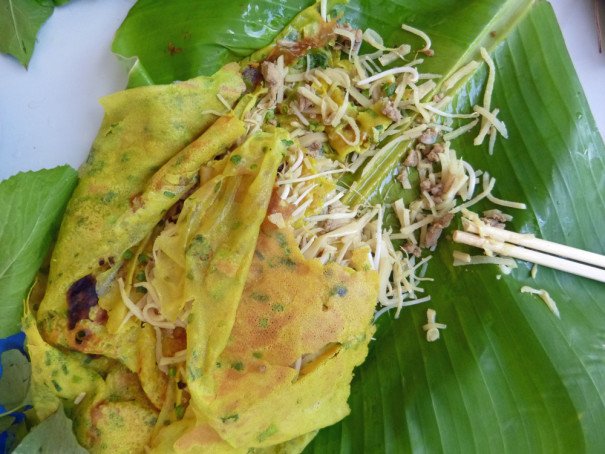
If the Perfect Breakfast Won’t Come to You, You Go to It

If the Perfect Breakfast Won’t Come to You, You Go to It
Bánh Xèo in the Mekong Delta
A confession: I’m not a breakfast person. I’m one of those people who likes to start the day with a big, fresh cup of coffee.
When I do eat breakfast, I generally prefer something hot for the simple reason that when I wake up, my body’s cold. But most of my favorite hot breakfast dishes are either too greasy and heavy (bacon and eggs) or too spicy (Hokkien mee and roti cani) to eat on a regular basis. And the fresh fruit and vegetables that I love are too cold to eat for breakfast outside of summer.
If I were to design the perfect breakfast, it would have the satisfying protein hit of freshly cooked, succulent meat; the lightness of a crispy omelette; the clean, refreshing taste of garden-fresh, green leafy vegetables; and, finally, a tangy, citrusy bite.
Until recently, as far as I knew, no such dish existed.
Last month, I journeyed to the tiny village of Rach Rung near the town of Hoa Binh in the Mekong Delta. My brother married a Vietnamese-Australian girl in Melbourne earlier this year. Rach Rung is her father’s ancestral village. He’s buried there. Custom required that we journey there for a wedding reception for my brother and my sister-in-law.
We stayed for three nights. Every morning, my sister-in-law’s lady relatives would make us breakfast. On the first morning, it was frog’s leg congee: delicious, but not mind-blowingly so. It was on the second morning that I came face-to-face with it for the very first time: my Holy Grail, my El Dorado, the perfect breakfast.
The dish is called bánh xèo. It consists of stir-fried and/or boiled minced or sliced pork wrapped in a thin, crispy, rice flour omelette which is, in turn, wrapped in a raw, fresh, green leafy vegetable. I’d had it many times before in the plentiful authentic Vietnamese restaurants we have back home in Melbourne.
But not like this. Back home, the restaurants cook the omelette over a standard gas stove. Here, the local ladies cooked the omelette outdoors over a wood fire. Somehow, this made the omelette thinner, crispier, and lighter. And, whereas the bánh xèo back home didn’t really have a noticeable aroma, here the smell of the wood-fire mixed with the natural fragrance of the fresh banana leaves on which the hot omelettes were served to create a warm, heady fragrance that formed an integral element of the dish.
The pork used by the Vietnamese restaurants in Melbourne is fine, but the pork here came from the pig pens behind the house and had been freshly butchered for our dining pleasure. You could taste the freshness of the pork; it was dripping in rivers of meat juice. In Melbourne, bean sprouts are typically the only notable accompaniment to the pork as a filling. Here, fresh, stir-fried bamboo shoots were added.
In Melbourne, the Vietnamese restaurants give you one—at most, two—types of green leafy vegetables to wrap your bánh xèo in, usually mustard leaves and/or lettuce leaves. Here, we were presented with what can only be described as a smorgasbord of green leafy vegetables picked from the garden that morning, plus an unidentified translucent, light purple leaf that no one knew the English name for. (The purple leaf had an interesting, slightly chewy texture and a unique, mildly bitter taste.)
Finally, there is the dipping sauce, an integral element in nearly all Vietnamese dishes. The dipping sauce used for bánh xèo is the most common one, known as nước chấm (literal translation: “dipping sauce”), made by mixing water with fresh lemon or lime juice, sugar, fish sauce, and chopped fresh chillies and/or garlic. The village version was both more citrusy and hotter than the typical Melbourne restaurant version, most likely due to the intensity of the fresh local chillies and limes used. Perfect breakfast accomplished.